Quizience is supported by you the audience. When you purchase through links on our site, we may earn an affiliate commission.
Portable power stations are more powerful and cost effective than ever before. And, thanks to advances in lithium-ion battery technology, they’re also lighter and more compact. Whether you’ve been dreaming of van life or are building out your emergency kit in advance of that next blackout, there is a power station that will meet your needs. To help you decide, I tested the efficiency, in a variety of scenarios, of the best portable power stations from Jackery, Oupes, EcoFlow, Anker, Goal Zero, Grecell, Bluetti, Dakota Lithium, Lion Energy, Vtoman, and Ugreen.
How I Tested the Best Portable Power Stations
I’ve been testing portable power stations for years as part of my ongoing test of the best solar generators. In that time I’ve noted the features that matter most for home emergencies and off-grid excursions, and where different brands and models struggle with reliability and efficiency. As I played around with these units, two main questions came into focus: Do these power stations really hold as much energy as they say they do? And how much of that energy is leaking out over time?
Other Considerations
I also queried manufacturers on the amount of power used by the power station when it is on and the AC ports are activated, the numbers for which are provided in the above table. Finally, I drilled down on the warranty to ensure that the limited five year warranty covered the most common pitfalls for users (typically, forgetting to power their power station up on a consistent enough basis, which can damage the battery over time).
I did not independently verify the weight of each of these units, but have listed manufacturer specifications above. Generally speaking, units with more watt hours and more features were heavier. With the new LiFePo4 battery chemistry, I personally found that units in the 1000 Wh range were fairly portable, while those that were closer to 1500 Wh were more of a chore to pick up and move around. Power stations that stood out as especially difficult or easy to move around have been noted in the individual reviews.
Assessing Price and Value
As of 2025, I’m evaluating the portable power stations on their price and relative value. The challenge with this analysis is that, in this category, “list price” is essentially meaningless. More often than not, power station manufacturers will run so-called sales on their products, to create the illusion that you are getting an especially great deal if you jump now to pick up a unit. Sometimes, especially around Black Friday, this is true. Usually it’s not; it’s companies trying to manufacture the false impression among consumers that something is a “deal” so that they make an uninformed purchase. Don’t fall for it, especially not in a category that’s this pricey.
In the below table, I’m assessing price in a few different ways. My primary tool for this is the Keepa widget. One limitation to this widget at present is that it is only tracking Amazon. However, since Amazon punishes its sellers for not providing them with the lowest price possible (something they are being sued for by the FTC), this is, for now, likely close enough.
- High Price: The highest price across the last 180 days
- Low Price: The lowest price across the last 180 days
- Average Price: The average price across the last 180 days
- Price per Usable Watt Hour: The average price of the unit divided by the usable kWh from the high-draw (~380W) testing scenario. This provides a sense of the relative value of the unit in terms of the amount of power it can hold.
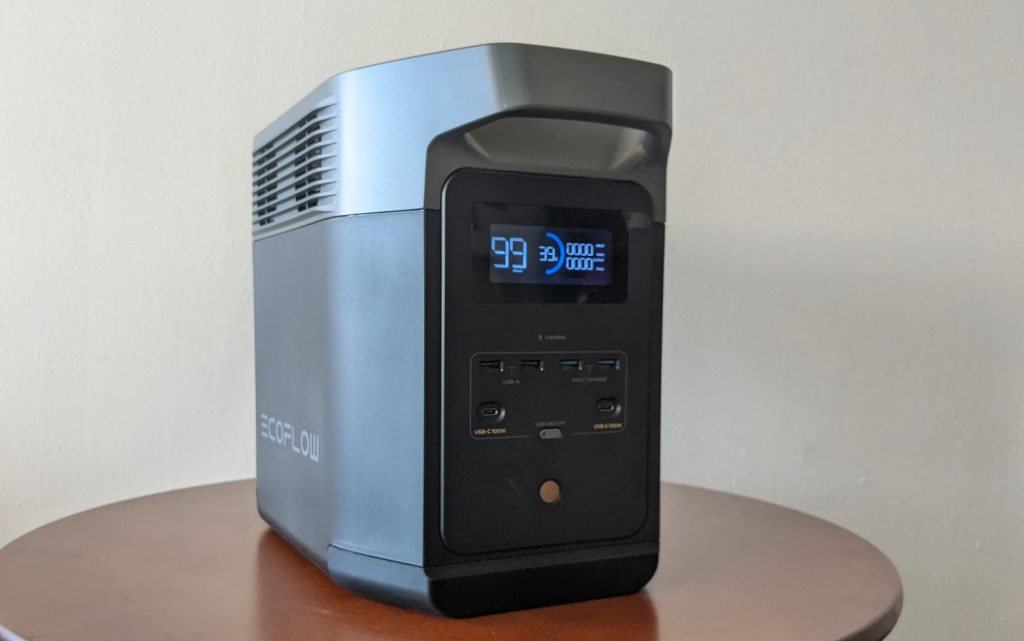
Best Overall: EcoFlow Delta 2
Pros
- Stronger performer in all testing categories
- Low weight
- Easy to use
- Great value for its power output
Cons
- Not water resistant
- The compatible EcoFlow solar panels aren’t my favorite
Report Card
- Stated Watt Hours: 1024
- Provided 67% of stated watt hour potential at a consistent 34W draw
- Provided 88% of stated watt hour potential at a consistent 380W draw
- Provided 83% of stated watt hour potential after 3 months in storage
- Recharge Time: 1 hour, 15 minutes
- Confirmed Max Wattage: 1800 watts
- AC Port and Inverter Power Use: 10 watts
- IP Rating: IP20
- Average Price per Usable Watt Hour: $0.84
Key Features
- Other Available Sizes: 2048 watt hours, 3600 watt hours
- Weight: 27 pounds
- Battery Chemistry: LiFePO4
- Manufacturer Claimed Lifecycles to 80 Percent Capacity: 3,000
- Warranty: 5 years
This one was close. While the Anker SOLIX C1000 had a slightly better efficiency rating for the large appliance test and long-term storage test, when it came down to powering my grow light, the EcoFlow Delta 2 lasted over an hour longer. I decided to weigh the grow light test more because I think it reflects how most people use portable stations: to provide a steady stream of low-wattage power into things like a laptop or smartphone. If that’s what you value, then the EcoFlow Delta 2 is the unit for you.
Both the USB-C ports on the EcoFlow Delta 2 were capable of 100Ws of output, which is handy if you are using a newer USB-C cable for your laptop. I was also impressed with how little additional energy it lost out of the five unused AC ports. I wish the AC ports were on the same side of the unit as the USB ports and information panel, but there are certainly situations where it’s handy to have the cords configured at the back of the power station.
The EcoFlow Delta 2 also stood out from the competition for its light weight (only the Ugreen PowerRoam was lighter at the same claimed wattage potential), and I found it easy to move around during testing. Finally, I was impressed with the accuracy of the on-board display, easily one of the most accurate during my final test after three months in storage.
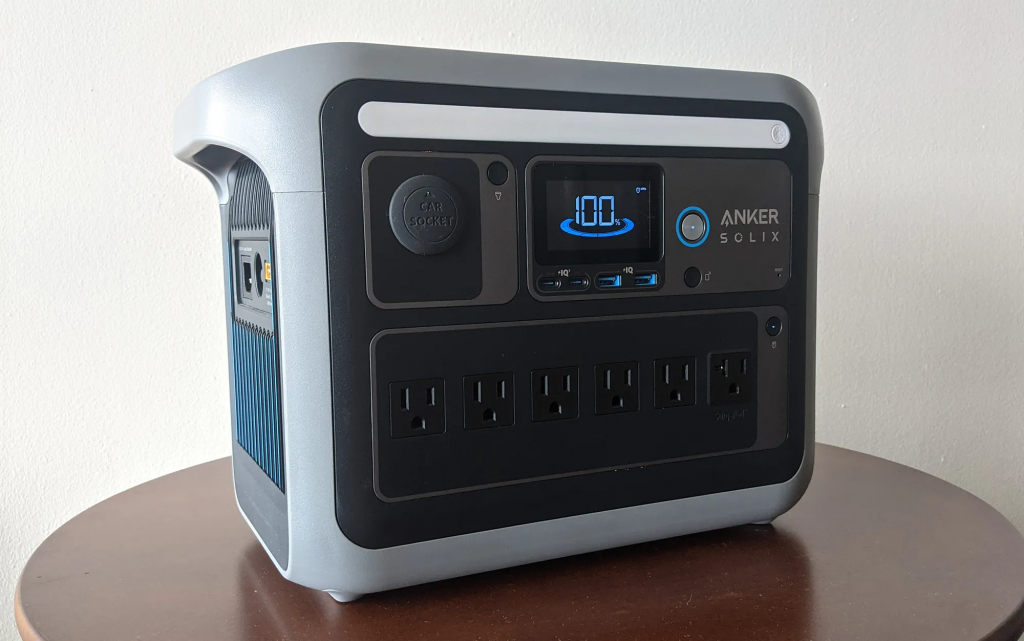
Best for Solar Generators: Anker SOLIX C1000
Pros
- Compact
- Best performance on the large power draw (dehumidifier) test
Cons
- Slightly longer recharge time than other models I looked at (option if you download their app to speed this up)
- Average price per usable watt hour is on the high side compared to other options
Report Card
- Stated Watt Hours: 1056
- Provided 62% of stated watt hour potential at a consistent 34W draw
- Provided 90% of stated watt hour potential at a consistent 380W draw
- Provided 86% of stated watt hour potential after 3 months in storage
- Recharge Time: 1.4 hours
- Confirmed Max Wattage: 1800 watts
- AC Port and Inverter Power Use: 25 watts
- IP Rating: None
- Average Price per Usable Watt Hour: $0.96
Key Features
- Other Available Sizes: None in this series, but other Anker models come in different sizes
- Weight: 28.5 pounds
- Battery Chemistry: LiFePO4
- Manufacturer Claimed Lifecycles to 80 Percent Capacity: 3,000
- Warranty: 5 years
The Anker SOLIX C1000 was a very close second to the EcoFlow Delta 2. It had a higher percentage of energy efficiency against its stated watt hour potential in the large appliance test and long-term storage test. While it had a more accurate reading in both tests with a fresh charge, it turned off with still 2 percent left on the onboard display after the long-term storage test. However, it did worse than the EcoFlow in the most important test using the 34W grow light, suggesting it has a less efficient overall inverter than the EcoFlow. It also took slightly longer to charge. But it’s really close, and if the Anker SOLIX C1000 is a few dollars less expensive than the EcoFlow Delta 2 at the time you’re making your purchase, you should absolutely get it.
You should also definitely choose the Anker SOLIX C1000 if you have any plans to convert your portable power station to a portable solar generator. In my testing of the best portable solar panels, I have been very impressed with the Anker panels, particularly their 100W panel, which includes a sundial to help you get the maximum energy potential in bright conditions. Conversely, I have been less impressed by the EcoFlow panels, which I have found tend to warp in storage after a few months.
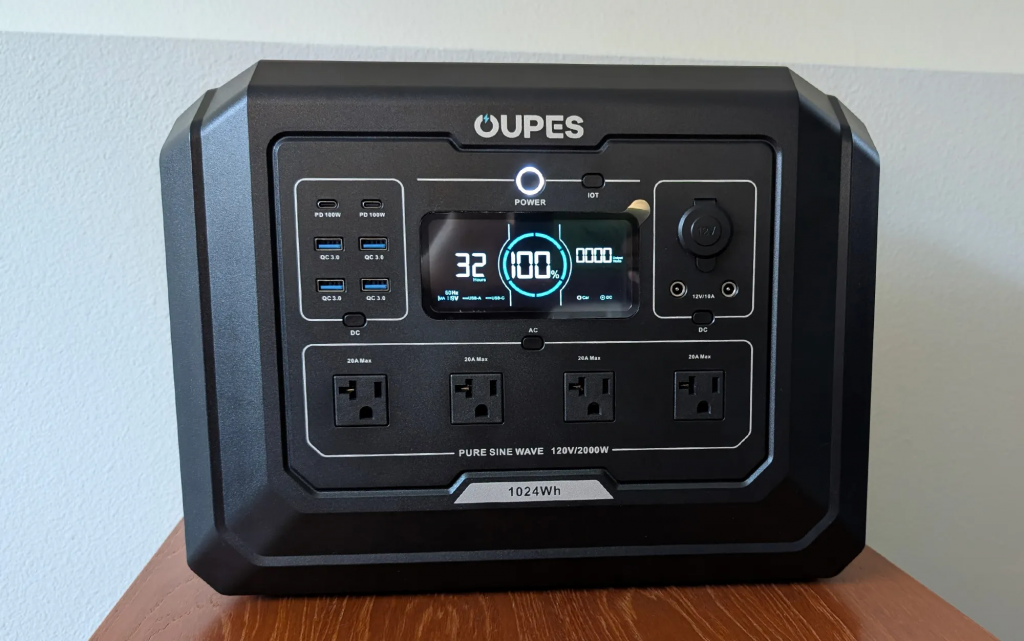
Best Budget: Oupes Mega 1
Pros
- Affordable
- Save 5 percent with code outdoorlife
Cons
- Not as efficient as other units I’ve tested
- Loses a ton of power when the AC port is on
Report Card
- Stated Watt Hours: 1024
- Provided 60% of stated watt hour potential at a consistent 34W draw
- Provided 76% of stated watt hour potential at a consistent 380W draw
- Long-term storage test in progress
- Recharge Time: 43 minutes
- Confirmed Max Wattage: 2000 watts
- AC Port and Inverter Power Use: 50 watts
- IP Rating: IP21
- Average Price per Usable Watt Hour: $0.64
Key Features
- Other Available Sizes: None in this series, but other Oupes models come in different sizes
- Weight: 27.8 pounds
- Battery Chemistry: LiFePO4
- Manufacturer Claimed Lifecycles to 80 Percent Capacity: 3,500
- Warranty: 3 years
In my initial round of testing with the Oupes, I was beyond impressed with its performance relative to its price. While it didn’t score stunning marks in my watt hour potential test (60 percent and 76 percent for the low-watt and high-watt draw test, respectively), it costs only 64 cents per watt hour, which is blowing the competition out of the water. It also boasts an impressively fast recharge time of only 43 minutes, one of the quickest I’ve tested.
Of course, there are always trade-offs with budget products and the Oupes is no exception. Part of the reason the Mega 1 didn’t score as high for efficiency as other options I looked at is because the combined inverter and AC port power use is unusually high. At 50 watts, it’s about three times what other power stations are using. I was also surprised in my high wattage test that the unit stopped supplying power to the AC port with 4 percent still left in the tank. Finally, the warranty isn’t as long as others that I looked at, and doesn’t quite reflect the lifespan of a unit that has 3,500 lifecycles before it hits 80 percent of its original capacity.
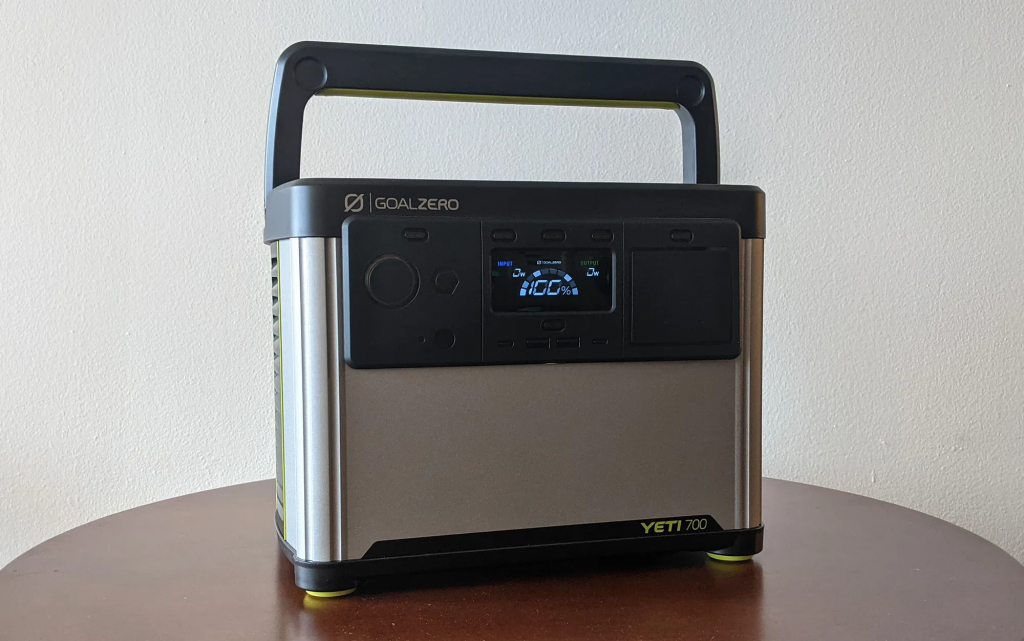
Most Reliable: Goal Zero Yeti 700
Pros
- The most efficient unit tested for the grow light test
- One of the few power stations to display the loss of power through the AC ports
Cons
- Somewhat less intuitive to use than other power stations I looked at
- The model I tested is not available in larger sizes (although other Goal Zero power stations are much, much larger)
- Expensive per usable watt hour
Report Card
- Stated Watt Hours: 677
- Provided 70% of stated watt hour potential at a consistent 34W draw
- Provided 83% of stated watt hour potential at a consistent 380W draw
- Provided 81% of stated watt hour potential after 3 months in storage
- Recharge Time: 1 hour, 58 minutes
- Confirmed Max Wattage: 600 watts
- AC Port and Inverter Power Use: 9 watts
- IP Rating: IPX4
- Average Price per Usable Watt Hour: $1.03
Key Features
- Other Available Sizes: 297 watt hours, 499 watt hours
- Weight: 20.9 pounds
- Battery Chemistry: LiFePO4
- Manufacturer Claimed Lifecycles to 80 Percent Capacity: 4,000
- Warranty: 5 years
The Goal Zero Yeti 700 was one of the most impressive units during testing. It achieved 70 percent efficiency against its stated 677Wh size and powered a 34W grow light for over 13 hours. While the Lion Energy Summit just squeaked by with the most efficient overall time, it was still showing 8 percent power left in the unit when it suddenly shut off.
Compare that to the Goal Zero Yeti 700, which lasted for a surprisingly long time even when the display still had it clocked at 1 percent. (In my final test after long-term storage, the Goal Zero Yeti 700 ran my dehumidifier for 10 minutes while only showing 1 percent power left.) Unlike other units I tested, the Goal Zero Yeti 700 also shows the power being used by the power station. To me, this is the right way to handle this: Users are more likely to wonder how much energy the power station is using to power a particular appliance then wonder how much energy the appliance itself is using. It also serves as a reminder to turn the AC outlets off when they aren’t in use, as they represent a fairly significant drain on the battery.
In terms of portability, I liked the fold down handle of the Yeti 700. It was comfortable to carry, in large part because of its comparatively small size. Its shorter height compared to the other units I looked at means it could be easily tucked onto a shelf in an already crowded closet for long-term storage.
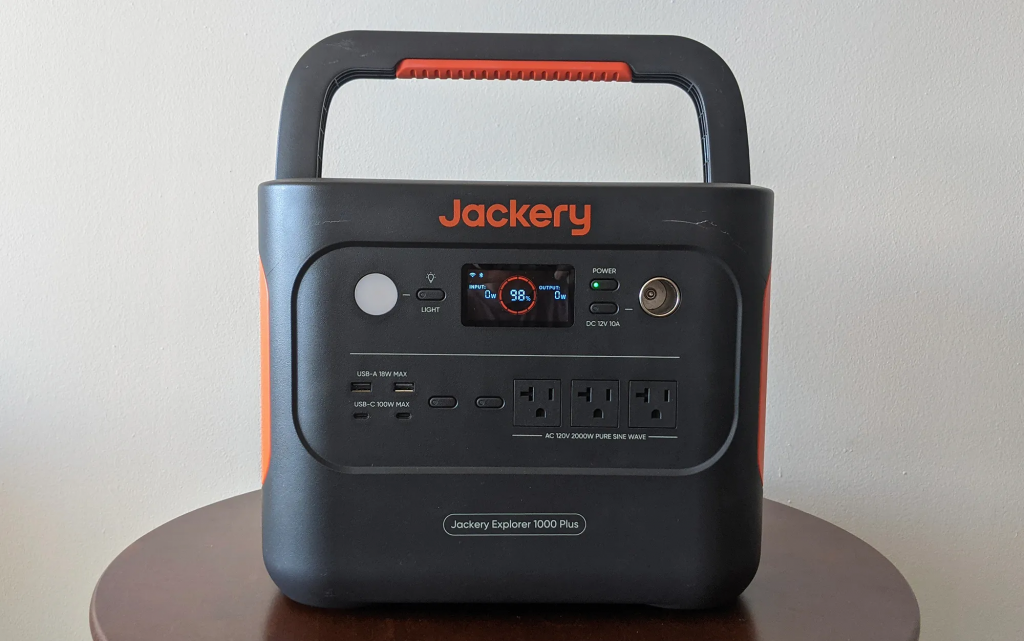
Easiest to Use: Jackery Explorer 1000 Plus
Pros
- Easy to use
- Efficient energy use
Cons
- Slightly longer recharge time than other models I looked at
- On the heavier side
- Some durability concerns
Report Card
- Stated Watt Hours: 1265
- Provided 49% of stated watt hour potential at a consistent 34W draw
- Provided 86% of stated watt hour potential at a consistent 380W draw
- Provided 82% of stated watt hour potential after 3 months in storage
- Recharge Time: 1.8 hours
- Confirmed Max Wattage: 2000 watts
- AC Port and Inverter Power Use: Unavailable
- IP Rating: None
- Average Price per Usable Watt Hour: $0.84
Key Features
- Other Available Sizes: 288 watt hours, 2043 watt hours
- Weight: 32 pounds
- Battery Chemistry: LiFePO4
- Manufacturer Claimed Lifecycles to 80 Percent Capacity: 4,000
- Warranty: 5 years
Jackery’s power stations have always stood out to me as being exceptionally easy to use, sort of like the iPhone of portable power stations. Their display panel is straightforward and intuitive, their bright-orange charging cables are color-coded to the power station itself. Anker and EcoFlow also do a great job in this area, but not quite at the level of Jackery. But, like the iPhone, it all comes at a cost. First off, this power station is typically pricier than its competitors, although that is difficult to quantify given the the number of sales there are for this category. It’s also heavier and bulkier. While I could comfortably lift the Goal Zero and Anker power stations, the Jackery power station was more of a chore to lug around.
Unfortunately, during testing it didn’t quite match the performance of other power stations. On the grow light test, in particular, it came in at 49 percent of its stated capacity, fully draining in less time than units with less capacity. It fared better on the dehumidifier test, fortunately. The display was reasonably accurate during this time, although the last 10 percent or so drained faster than it had at the start. Of more concern, somewhere in my testing, this unit picked up some cracks in the housing. I did not include a durability test in my protocol; this was something that happened in the course of moving the power station around for testing. It’s disappointing and the first time I have had this happen in my testing of dozens of power stations. I hope that Jackery looks at improving the durability of the housing in the future.
